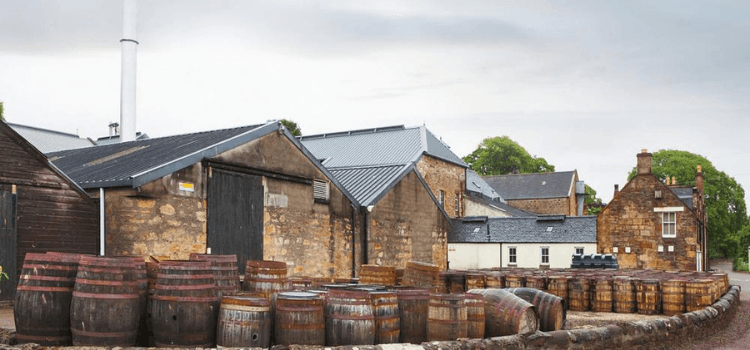Scotch Whisky Regions
April 25 2021 – David Lemmond

Currently, Rustic & Main carries whisky barrel woods from three of the five whiskey-producing regions of Scotland: the Highlands, Islay, and Speyside. In this blog, we’ll explore those three regions, as well as the three types of scotch produced, including single malt (malted barley), grain (wheat, maize, or unmalted barley), and blended (malt and grain blend). The brands referenced below are ‘single malt’ type distilleries. However, most of the brands are also utilized in whisky blends.
But first, what is a “malt whisky”?
According to The Whiskey Exchange,
“Malt whisky is the ‘original’ whisky of Scotland. Malt whisky is made only from malted barley, in two (occasionally three) copper pot stills, by a batch process. ‘Single’ malt whisky is the product of an individual distillery…[and] must be matured in oak casks in Scotland, and the casks themselves can make a huge contribution to the flavour of the finished product, according to a) how long the whisky has been left to mature, b) how often the individual cask has been used to mature Scotch and c) whether the cask is made from European oak or American oak.”
Speyside Region
Let’s begin our journey to Scotland in the Speyside region, since it has the largest number of distilleries in Scotland. Speyside is also home to the world’s most famous and best-selling Single Malt Whiskys, including one of our top-shelf brands, Macallan.
Macallan (The Rolls-Royce of Single Malts)
The Macallan Distillery was founded in 1824 and sits just above the river Spey. What is not sold as Single Malt is blended by other brands. Their wooden barrels account for up to 80% of the final aroma and flavor of their whisky, and the use of an oak cask ensures a high-quality and unique style of the single malt. Further, whisky maturing is carried out in three distinct types of casks/processes: sherry oak, double, and triple.
- The whisky is matured in sherry seasoned oak from Jerez, Spain.
- New American and European sherry seasoned oak are used simultaneously for maturing, and then the two are blended.
- The new American and European sherry seasoned oak casks and bourbon seasoned barrels are used simultaneously for maturing, and then the three types of whisky are blended. In this way, each of the three maturing methods produces a distinct aroma and flavor based on the barrels utilized.
BenRiach
The BenRiach Distillery was founded in 1898. Up until 1999, they malted their own barley in-house. The malting floor and machinery was restored in 2012, providing in-house malting once again. The water source is a natural underground spring, located below the distillery. Copper stills are used for distilling, while maturing/finishing is carried out in ex-bourbon barrels, virgin oak, and Oloroso sherry.
Tormore
The Tormore Distillery was built in 1958 and was one of the first new distilleries to appear during the 20th century. Tormore’s main water source flows through peat and wild heather and over granite hills until it reaches the distillery, leaving it pure and crystal clear. American oak casks are used for maturation.
Aultmore
Built in 1896, Aultmore Distillery is part of Dewar’s White Label Blend (the world's most-awarded blended Scotch Whisky). It is also available as a single malt (part of the “Last Great Malts” collection). Known locally as “a nip of the Buckie Road,” Aultmore is a rare Speyside malt that gets its water from a mysterious area known as the Foggie Moss. Rated top-class, Aultmore is one of the few distilleries that still use barley grown in Scotland. The whisky is aged in oak barrels for a minimum of three years.
Highlands Region
Next, we venture into the Highlands, known for its stunning landscapes and unique culture.
Teaninich
The Teaninich Distillery was one of the first legal distilleries established in 1817. Founded by a Scottish clan chief, Capt. Hugh Munro, it is primarily used in blended whiskies, including the iconic Scotch Whisky, Johnnie Walker. The whisky is matured in both refill American oak hogsheads and refill American oak barrels.
Glencadam
The Glencadam Distillery was established in 1825. The majority of production is used in top-selling brands, such as Ballantine’s and Stewart's Cream of the Barley Blends. The water source is pure Highlands spring water drawn from springs at The Moorans. The whisky is matured for a minimum of 10 years in charred ex-bourbon barrels. Oloroso sherry from Spain and Portwood from Portugal are used as finishing casks for 2 years.

Islay Region (Rugged Hebridean Isles)
Finally, we end in Islay (pronounced eye-luh), which is world-known for its strong-flavored, peaty and smoky malt whisky.
Lagavulin
Started in 1742 and officially established in 1816, Lagavulin Distillery matures their whiskey in oak casks for a minimum of 16 years. Their barley gets its distinct smoky flavor from the vast peat bog on the west side of the island, and the rich, peaty water that runs down to the distillery from the Solan Lochs. The brand has won numerous awards, including nine Gold Medals at the International Wine and Spirit Competitions, and is one of the six classic malts of Scotland.
Laphroaig (pronounced la-froyg)
Started in 1815, the whisky from Laphroaig Distillery is matured in ex-bourbon and sherry casks. The peat bogs on the Glenmachrie Peat Moss are what give the whisky its peaty flavor. Their special malt barley is steeped in the uniquely soft, peaty water of Kilbride Dam, Laphroaig’s primary water source, just before the malting process. It is then smoked and dried on peat fired kilns giving it its characteristic flavor. Laphroaig is one of the few distilleries remaining that turns the malt by hand during the week-long germinating period, helping it to maintain an even temperature. Most of the original buildings from the distillery remain -- even the malting floors -- and it is this unwavering desire to stick to the traditional distilling process that makes Laphroaig one of the best single malts in the world.
Capturing the Essence of Scotch Whisky in a Ring
The wooden barrels have a significant role to play in developing the finished whisky product. Additionally, the whisky and external natural elements of Scotland are absorbed into the wooden barrels, capturing the uniqueness of each region. In this way, the fundamental elements of Scottish landscapes, heritage, and history can be worn as a fine piece of art.
Rustic & Main is proud to offer rare and top shelf Scotch whisky barrel woods as ring bases, liners, and inlays, available in either a weathered or natural state. Whisky and cultural heritage enthusiasts can now commemorate the roots of whisky making in a ring. Start designing your own custom ring today!


